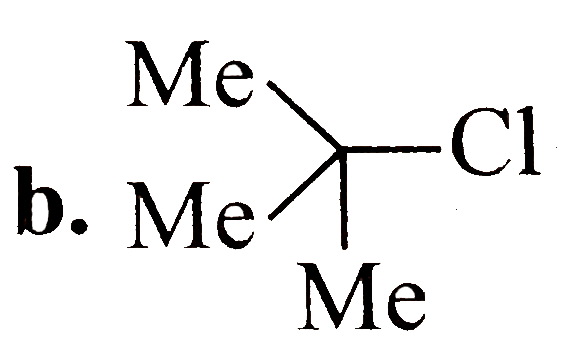Equal amount of an RCl(C4H9Cl) is reacted at the same temperature with equal volume of 0.2M and 0.4M solution of KOH, respectively, in two separate experiments. The time taken for the reaction of 50% of (C4H9Cl) was found to be same, the alkyl halide is :




The correct Answer is:B
To solve the problem, we need to analyze the information given about the reaction of the alkyl halide C4H9Cl with two different concentrations of KOH.
1. Understanding the Reaction:
- We have an alkyl halide C4H9Cl reacting with KOH.
- The concentrations of KOH used are 0.2M and 0.4M.
2. Observing the Reaction Rate:
- The time taken for the reaction to reach 50% completion is the same for both concentrations of KOH.
- This indicates that the rate of reaction is independent of the concentration of the nucleophile KOH.
3. Identifying the Reaction Mechanism:
- Since the rate of reaction does not depend on the concentration of KOH, we can conclude that the reaction follows an SN1 mechanism.
- In an SN1 mechanism, the rate-determining step involves the formation of a carbocation, which is dependent only on the concentration of the alkyl halide.
4. Determining the Type of Alkyl Halide:
- The SN1 mechanism is favored by tertiary (3°) alkyl halides, followed by secondary (2°) and then primary (1°) alkyl halides.
- Given that the reaction is independent of the nucleophile concentration, we can infer that C4H9Cl must be a tertiary alkyl halide.
5. Conclusion:
- Therefore, the alkyl halide C4H9Cl is a tertiary alkyl halide.
Final Answer:
The alkyl halide is a tertiary alkyl halide (3° halide).
---
- We have an alkyl halide C4H9Cl reacting with KOH.
- The concentrations of KOH used are 0.2M and 0.4M.
- The time taken for the reaction to reach 50% completion is the same for both concentrations of KOH.
- This indicates that the rate of reaction is independent of the concentration of the nucleophile KOH.
- Since the rate of reaction does not depend on the concentration of KOH, we can conclude that the reaction follows an SN1 mechanism.
- In an SN1 mechanism, the rate-determining step involves the formation of a carbocation, which is dependent only on the concentration of the alkyl halide.
- The SN1 mechanism is favored by tertiary (3°) alkyl halides, followed by secondary (2°) and then primary (1°) alkyl halides.
- Given that the reaction is independent of the nucleophile concentration, we can infer that C4H9Cl must be a tertiary alkyl halide.
- Therefore, the alkyl halide C4H9Cl is a tertiary alkyl halide.
The alkyl halide is a tertiary alkyl halide (3° halide).
Topper's Solved these Questions
- BOOK - CENGAGE CHEMISTRY ENGLISHCHAPTER - ORGANIC REACTION MECHANISMEXERCISE - Assertion-Reasoning12videos
ORGANIC REACTION MECHANISM
- BOOK - CENGAGE CHEMISTRY ENGLISHCHAPTER - ORGANIC REACTION MECHANISMEXERCISE - Archives8videos
ORGANIC REACTION MECHANISM
- BOOK - CENGAGE CHEMISTRY ENGLISHCHAPTER - ORGANIC REACTION MECHANISMEXERCISE - Multiple Correct30videos
ORGANIC REACTION MECHANISM
- BOOK - CENGAGE CHEMISTRY ENGLISHCHAPTER - NCERT BASED EXERCISEEXERCISE - Chemical Equilibrium73videos
NCERT BASED EXERCISE
- BOOK - CENGAGE CHEMISTRY ENGLISHCHAPTER - P-BLOCK GROUP 13 - BORON FAMILYEXERCISE - Exercise Archives (Subjecive)9videos
P-BLOCK GROUP 13 - BORON FAMILY
Similar Questions
Knowledge Check
- Question 1 - Select One
In two separate experiments equal quantities of alkyl halide, C4H9Cl, were treated at the same temperature with equal volume of 0.1 molar and 0.2 molar solutions of NaOH respectively. In the two experiments, t1/2 of the two reaction were the same. The most likely structure of halide is
ACH3CH2CH2CH2ClBCH3CH(Cl)CH2CH3C(CH3)2CHCH2ClD(CH3)3CCl
Total number of isomers of C4H9Cl are
View SolutionThe number of structural isomers of for C4H9Cl are:
View SolutionFrom the data given below, calculate the average rate of the reaction :
C4H9Cl+H2O→C4H9OH+HCl during different intervals of time.
 View Solution
View SolutionFrom the data given below, calculate the average rate of the reaction :
C4H9Cl+H2O→C4H9OH+HCl during different intervals of time.
 View Solution
View SolutionFrom the data given below, calculate the average rate of the reaction :
C4H9Cl+H2O→C4H9OH+HCl during different intervals of time.
 View Solution
View SolutionUnder the same conditions, how many mL of MKOH and 0.5MH2SO4solutions, respectively, when mixed to form a total volume of 100mL, produces the highest rise in temperature?
View SolutionThe resistance of two electrolytes X and Y ere found to be 45 and 100 respectively when equal volumes of both the solutions were taken in the same cell in two different experiments. If equal volumes of these solutions are mixed in the same cell, what will be the conductance of the mixture?
View Solution
